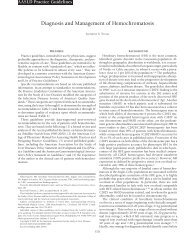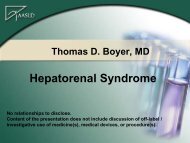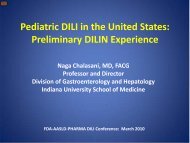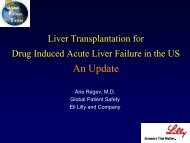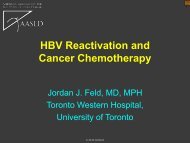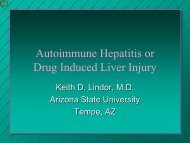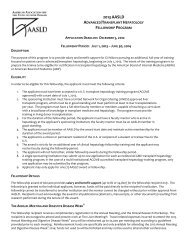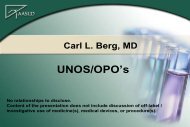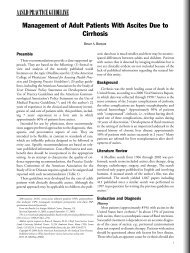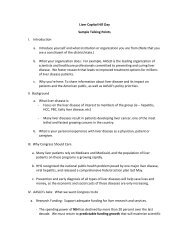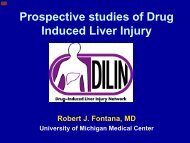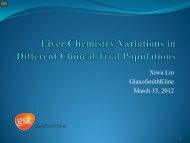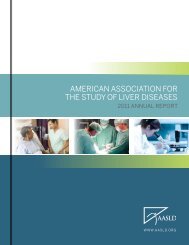URSODIOL FOR PRIMARY BILIARY CIRRHOSIS - AASLD
URSODIOL FOR PRIMARY BILIARY CIRRHOSIS - AASLD
URSODIOL FOR PRIMARY BILIARY CIRRHOSIS - AASLD
You also want an ePaper? Increase the reach of your titles
YUMPU automatically turns print PDFs into web optimized ePapers that Google loves.
Keith D. Lindor, MD<br />
Cholestatic Disease<br />
Grant Research Support: Axcan, Intercept<br />
Content of the presentation does include discussion of offlabel/investigative<br />
use of medicine(s), medical devices, or procedure(s).<br />
Ursodeoxycholic Acid-PSC
CHOLESTATIC DISEASE<br />
KEITH D. LINDOR, M.D.<br />
MAYO CLINIC<br />
ROCHESTER, MN
UPDATE<br />
• PBC<br />
• PSC<br />
• Complications of cholestasis
<strong>PRIMARY</strong> <strong>BILIARY</strong> <strong>CIRRHOSIS</strong><br />
• DEFINITION<br />
– Chronic cholestatic liver disease<br />
– Usually affects women (10:1) in middle age<br />
– Chronic, non-destructive lymphocytic cholangitis<br />
– Slowly progressive
EPIDEMIOLOGY OF PBC<br />
Changes Over Time - Prevalence<br />
1970s 1980s 1990s 2000s<br />
Newcastle (1) 180/mil 240/mil<br />
NE England (2) 202/mil 335/mil<br />
Rochester, MN (3)<br />
402/mil<br />
Sheffield (4) 57/mil 136/mil 238/mil<br />
(1) Intl J Epi 1997;26:830-6. (2) Hepatology 1999;30:390-4.<br />
(3) Gastroenterology 2000;199:1631-1636. (4) Hepatology 2001;34:370A.
EPIDEMIOLOGY OF PBC<br />
Changes Over Time - Incidence<br />
Female rate<br />
(95% CI)<br />
Male rate<br />
(95% CI)<br />
Total rate<br />
(95% CI)<br />
1975-1979 4.9 (1.7-8.1) 0 (0-0) 2.5 (0.8-4.2)<br />
1980-1984 3.9 (1.2-6.6) 0.5 (0-1.5) 2.5 (0.9-4.1)<br />
1985-1989 4.4 (1.6-7.2) 1.4 (0-3.3) 3.0 (1.3-4.7)<br />
1990-1995 4.7 (2.2-7.2) 0.8 (0-1.9) 2.8 (1.4-4.3)<br />
Overall 4.5 (3.1-5.9) 0.7 (0.1-1.3) 2.7 (1.9-3.5)<br />
Kim, et al. Gastroenterology 2000;119:1631-1636
PROGNOSTIC MODELS IN PBC<br />
Dickson<br />
et al<br />
Rydning<br />
et al<br />
Christensen<br />
et al<br />
Poupon<br />
et al<br />
Bilirubin X X X X<br />
Age X X<br />
Serum Albumin X X<br />
Prothrombin Time X X<br />
Edema/Ascites X X<br />
Bleeding varices X X<br />
Cirrhosis<br />
IgM<br />
UDCA-treated<br />
Procollagen III<br />
Hyaluronic Acid<br />
X<br />
X<br />
X<br />
X<br />
X
WORSE PROGNOSIS IF:<br />
• ANA +<br />
(Yang W, et al Clin Gastroenterol Hepatol 2004;2:1116-22)<br />
• Anti-centromere +<br />
(Yang W, et al Clin Gastroenterol Hepatol 2004;2:1116-22)<br />
• Gp210 +<br />
(Nakamura M, et al. J Hepatol 2005;42:386-92)
OVERLAP FEATURES<br />
• IgG > 2.0 mg/dL<br />
• ANA/SMA > 1:80<br />
• Interface hepatitis<br />
• Presence of other autoimmune diseases
OUTCOMES<br />
60<br />
50<br />
P
<strong>PRIMARY</strong> <strong>BILIARY</strong> <strong>CIRRHOSIS</strong><br />
• DIAGNOSIS<br />
– Chronic cholestasis (alkaline phosphatase)<br />
– Antimitochondrial antibody<br />
– Compatible liver biopsy
ROLE OF LIVER BIOPSY IN PBC<br />
• If:<br />
– ⊕AMA (95-98%)<br />
– Alk Phos > 1.5 times normal<br />
– AST < 5 times normal<br />
• Then:<br />
– positive predictive value for PBC > 98%<br />
(sensitivity 80%, specificity 92%)<br />
Zein CO, et al. Clin Gastro and Hepatol 2003;1:89-95.
DIAGNOSIS OF AMA PBC<br />
• Compatible biopsy<br />
• ANA and/or SMA in 95%
NATURAL HISTORY OF PBC<br />
Effects of UDCA<br />
Poupon RE, et al. Hepatology 1999;29:1668-1671.
PREDICTED SURVIVAL RATES<br />
Corpechot C et al. Gastroenterology 2005;128:297-303.
SURVIVAL TO DEATH OR LIVER<br />
TRANSPLANT OF PBC PATIENTS TREATED<br />
WITH UDCA—ALL PATIENTS<br />
Pares A, et al. Gastroenterology 2006;130:715-20
SURVIVAL TO DEATH OR LIVER TRANSPLANT<br />
OF PBC PATIENTS TREATED WITH UDCA—<br />
RESPONDERS (Alk phos. < 40% baseline or normal)<br />
Pares A, et al. Gastroenterology 2006;130:715-20
SURVIVAL TO DEATH OR LIVER TRANSPLANT<br />
OF PBC PATIENTS TREATED WITH UDCA—<br />
NON-RESPONDERS<br />
Pares A, et al. Gastroenterology 2006;130:715-20
COMBINATION THERAPY <strong>FOR</strong> PBC<br />
• Ursodiol Alone<br />
– biochemical normalization in ~ 1/3<br />
– risk scores or alkaline phosphatase response<br />
predictive (Angulo, et al. Liver 1999;19:119-1121)<br />
– various drugs tried in combination
COMBINATION THERAPY <strong>FOR</strong> PBC<br />
Ineffective Equivocal or Unknown Promising<br />
Colchicine Corticosteroids Combivir<br />
Cholylsarcosine CellCept Bezafibrate<br />
Methotrexate<br />
Budesonide<br />
Silymarin<br />
Double-dose UDCA
THERAPY <strong>FOR</strong> PBC -<br />
CURRENT RECOMMENDATIONS<br />
– Ursodiol at 13-15 mg/kg/day<br />
– initiate slowly<br />
– Consider for suboptimal responders<br />
experimental therapeutic trials with other agents
HEPATOCELLULAR CANCER RISK<br />
IN PBC<br />
• 18 Patients among 2000 over 25 years<br />
• Multivariate Analysis<br />
O.R P<br />
Age 1.6
<strong>PRIMARY</strong> SCLEROSING CHOLANGITIS<br />
• OVERVIEW<br />
– Diagnosis<br />
– Natural history/prognosis<br />
– Management of PSC complications<br />
– Management<br />
– surgical/endoscopic<br />
– medical<br />
– liver transplantation
<strong>PRIMARY</strong> SCLEROSING CHOLANGITIS<br />
• DEFINITION<br />
– Chronic cholestatic liver disease<br />
– Unknown etiology, frequently associated with<br />
IBD in ¾<br />
– Diffuse inflammation and fibrosis of biliary tree<br />
– Usually leads to biliary cirrhosis and portal<br />
hypertension
<strong>PRIMARY</strong> SCLEROSING CHOLANGITIS<br />
• DIAGNOSIS<br />
– ERCP most commonly used<br />
– Percutaneous cholangiography infrequently<br />
used<br />
– Magnetic resonance cholangiography emerging<br />
• non-invasive<br />
• no radiation<br />
• cost-effective
<strong>PRIMARY</strong> SCLEROSING CHOLANGITIS<br />
• DIFFERENTIAL DIAGNOSIS<br />
– Choledocholithiasis<br />
– Previous biliary surgical trauma<br />
– Cholangiocarcinoma<br />
– Metastatic involvement (rare)<br />
– HIV<br />
– Caustic strictures<br />
– Ischemic stricture post transplant
<strong>PRIMARY</strong> SCLEROSING CHOLANGITIS<br />
• LIVER BIOPSY<br />
– Role of liver biopsy being defined<br />
– May help prognostically<br />
• not used in some models<br />
– May help exclude other diseases<br />
– In setting of cholestasis and IBD with normal<br />
cholangiogram<br />
• small-duct PSC may be diagnosed
<strong>PRIMARY</strong> SCLEROSING CHOLANGITIS<br />
• Small-duct PSC<br />
– 5% of PSC<br />
– Normal cholangiogram but biopsy showing PSC<br />
– Can progress to classic PSC
SURVIVAL IN PSC –<br />
SMALL DUCT VS. LARGE<br />
Bjornsson E, et al. Gastroenterology 2008;134:975-80
<strong>PRIMARY</strong> SCLEROSING CHOLANGITIS<br />
• Natural History<br />
– progressive<br />
– median survival 12-17 years
PSC SURVIVAL IN OLMSTED<br />
COUNTY MINNESOTA<br />
Bambha K, et al. Gastro 2003;125:1364-1369.
<strong>PRIMARY</strong> SCLEROSING CHOLANGITIS<br />
• Specific Therapy<br />
– surgical therapy seldom used<br />
– dilation for complications<br />
– medical
<strong>PRIMARY</strong> SCLEROSING CHOLANGITIS<br />
Management of specific complications<br />
• Dominant biliary strictures<br />
– uncommon<br />
– cytology insensitive for cancer<br />
• other methods (DIA & FISH) being evaluated<br />
– long-term stents may cause problems<br />
– dilatation alone seems preferable
<strong>PRIMARY</strong> SCLEROSING CHOLANGITIS<br />
Specific Therapy<br />
• Medical therapy tested to date<br />
Penicillamine Colchicine Mycophenolate Mofetil<br />
Cyclosporine Methotrexate Silymarin<br />
Pentoxifylline Budesonide Tacrolimus<br />
Nicotine Pirfenidone Ursodeoxycholic acid<br />
Azathioprine Etanercept<br />
_____ = possible benefit
AUTOIMMUNE PANCREATITIS/<br />
CHOLANGITIS IN PSC<br />
• IgG4 elevated in 9% PSC patients<br />
• These patients may be more steroid<br />
responsive.
COMPARISON OF CHOLANGIOGRAM<br />
Band-like<br />
stricture<br />
BETWEEN PSC AND SC WITH AIP<br />
Segmental<br />
stricture<br />
PSC SC with AIP P Value<br />
++ -
HIGH DOSE URSO IN PSC<br />
Primary Endpoints UDCA Placebo<br />
Death 3 4<br />
Liver Transplant 9 3<br />
Minimal Listing Criteria for Liver 12 10<br />
Transplant<br />
Cirrhosis 5 3<br />
Esophageal and/or Gastric Varices 14 6<br />
Cholangiocarcinoma 2 1
<strong>PRIMARY</strong> SCLEROSING CHOLANGITIS<br />
Management of specific complications<br />
• Cholangiocarcinoma<br />
– may occur in 7-15%<br />
– incidence 0.5 to 1% per year<br />
– Smoking and IBD risks<br />
– Also at risk for liver cell, pancreatic, and colon<br />
cancer
Incidence of Cholangiocarcinoma<br />
Cumulative incidence of<br />
cholangiocarcinoma (%)<br />
10<br />
7.5<br />
5<br />
2.5<br />
0<br />
0 2 4 6<br />
Years since PSC diagnosis
COLON CANCER/IBD/PSC<br />
50%<br />
PSC/CUC<br />
CUC<br />
Risk %<br />
31%<br />
9%<br />
2%<br />
5%<br />
10%<br />
10 Years 20 Years 25 Years<br />
Broome, et al. Hepatology 1995;22:1404-8.
LIVER TRANSPLANTATION<br />
Cholestatic Liver Disease<br />
• Liver transplantation<br />
– Survival<br />
1 year 90-97%<br />
5 years 85-88%<br />
– Problems with rejection, infection, recurrence,<br />
colon cancer with PSC
CONCLUSIONS<br />
• PBC treated with UDCA – 13-15 mg/kg/d<br />
• PSC – no known effective therapy<br />
– dilations for strictures<br />
• Malignancy can complicate both PBC &<br />
PSC<br />
• Complications of cholestasis can be<br />
managed



